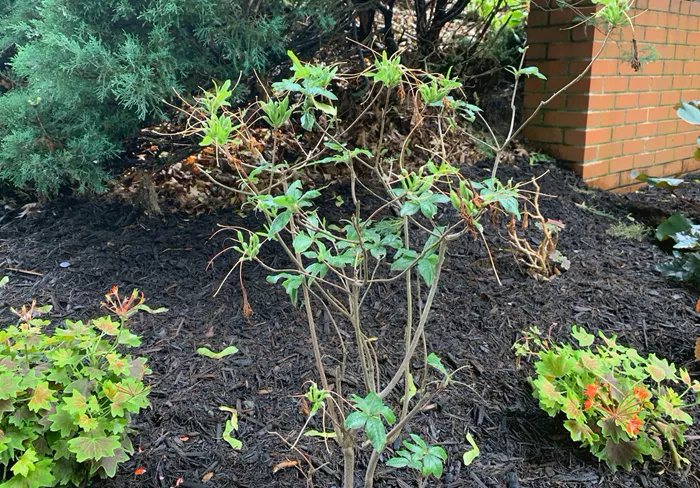If your trees, shrubs, and evergreens look just as small now as they did at the start of the season—or worse, appear spindly or unhealthy—you might need to consider a rescue plan for your garden in 2025.
The 2024 growing season was tough, with long stretches of scorching 90-degree days and inconsistent rainfall. If you’ve watered adequately but still see no improvement, there may be deeper issues affecting your plants. This is especially true for those that have failed to thrive since you first planted them.
Two main problems typically cause landscape plants to struggle.
Compacted Soil
One significant issue is poor soil quality. Many homes are built on compacted “builder’s soil,” which is often a mix of clay, shale, and subsoil laid over compacted earth during construction.
In central Pennsylvania, heavy, compacted clay soil is common. Unfortunately, this soil can stifle plant growth unless you improve it by adding compost, rotted leaves, or other organic matter. Without this amendment, many plants will struggle to thrive. They may stunt, rot due to poor drainage during wet weather, or die during droughts because their roots cannot penetrate the hard soil. This can also increase their vulnerability to pests and diseases.
Inappropriate Plant Placement
Another common mistake is planting in unsuitable locations. Many novice gardeners believe they can place any plant wherever it looks good, but this is not the case.
Plants that require full sun will not thrive in shady areas, and shade-loving plants can suffer in too much sun, leading to leaf burn or death. Additionally, plants that prefer moist soil will struggle in dry areas, while drought-resistant species can rot in low-lying spots.
It is crucial to match plants to the right environment before planting.
Root Competition from Trees
Another often-overlooked issue is planting near large trees. While the shade from tree canopies is a concern, the roots pose an even bigger problem. Tree roots can easily outcompete surrounding plants for nutrients and moisture, especially if those plants were planted after the tree had established itself.
Generally, the larger the tree, the more extensive its root system. Tree roots typically extend two to three times as wide as the branches above. Additionally, some trees release chemicals that inhibit the growth of neighboring plants. For example, juglone from walnut trees can be harmful or even fatal to sensitive species like hydrangeas and rhododendrons.
Increasingly erratic weather also affects plant health. High temperatures above 80 degrees can be detrimental to many landscape plants, while sudden droughts and heavy rains hinder sustained growth.
What Not to Do
Before discussing potential solutions, it’s important to highlight two common misconceptions.
Myth 1: Fertilizing Will Solve the Problem
Many gardeners mistakenly believe that fertilizers are a cure-all for struggling plants. However, fertilizers are only beneficial when plants lack specific nutrients. In many cases, soils already contain adequate nutrients, and adding more can be harmful.
Instead of fertilizing without reason, consider testing the soil to identify any deficiencies. Penn State University’s Agricultural Analytical Services Lab offers affordable soil tests through county Extension offices and online.
Myth 2: Waiting Will Improve Conditions
Another common belief is that struggling plants will eventually recover on their own. While plants do their best to survive, they rarely overcome poor soil or improper placement to thrive again. More often, they continue to decline.
A Better Approach: Transplanting
So, what should you do? While it may seem drastic, digging up and relocating struggling plants is often the best long-term solution. Improving the soil and replanting in the same spot can lead to significant improvement, while sometimes moving the plant to a better location is necessary.
Here are some tips for transplanting:
Minimize Stress: Dig up as much of the root ball as possible, and prepare the new planting area with compost to reduce the time the plant is out of the ground.
Transport Carefully: Use a tarp, burlap, or sturdy cloth to support the root ball during transport, preventing soil clumps from falling off and damaging the roots.
Timing is Key: Avoid transplanting during hot, dry weather. Early spring or early fall are ideal times, especially before a rainy spell or during cloudy conditions.
Transplanting also allows you to fix other planting mistakes, such as improper depth or leaving burlap on the root ball. Sometimes, moving a plant just a few feet can improve its light conditions significantly.
If tree roots are causing issues, it’s usually acceptable to remove up to 10 percent of the tree’s feeder roots when replanting. This may allow struggling plants to establish a foothold before the tree roots grow back.
Conclusion
In summary, don’t overlook the shovel when dealing with stunted plants. Transplanting is one of the most effective solutions in your gardening toolkit.
Related topics:
- Why Do My Spider Plants Always Die? The Solution Is Here!
- The Mystery Of Water Hyacinth Root System
- When to Divide Perennials for Quick Growth and Abundant Blooms?

